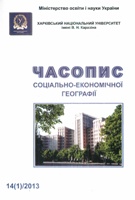Influence of contamination of drinking-water on the state of health of population of Kharkov area
Abstract
The problem of influence of drinking-water, muddy toxic matters is examined, on a health people, that is conditioned the anthropogenic loading on akval'nye natural landscapes are surface-water, 80% which are the source of drinkable water-supply. The comparative analysis of toxicness of drinking-water which is given the population of cities Kharkiv, Izum, Chuhuiv and Pervomaiskyi from the superficial sources of water-supply and artesian mining holes. On results a biotesting the presence of toxic properties of water the tests of which were taken away from the superficial sources of water-supply of citiesKharkovand Chuguev, and also artesian mining holes, is set in Izum. It is set that reason of toxic properties of drinking-water can be a presence in it remaining total chlorine. A coefficient of plural correlation between the expected risk for the health of people and maintenance in the drinking-water of remaining total chlorine is 0,86.
Downloads
References
2. Khvesyk M.A., Yarotska O.V. Upravlіnnya vodnymy resursamy Ukrainy. – K.: RVPS NAN Ukrainy, 2004. – 52 s.
3. Nacіonalna dopovіd pro stan navkolyshnoho pryrodnoho seredovyshha v Ukrainі u 2011 rocі. – Kyiv, 2012.
4. Derzhavnі sanіtarnі pravyla і normy «Voda pytna. Hіhіyenіchnі vymohi do yakostі vody centralіzovanoho hospo-darsko-pytnogo vodopostachannya» (zatverdzheno Nakazom MOZ Ukrainy vіd 23.12.96 za № 383; zareyestrovano v mіnіsterstvі yustycіyi za № 136/1940 vіd 15.04.97).
5. KND 211.1.4.055-97. Metodyka vyznachennya hostroyi letalnoyi toksychnostі vody na rakopodibnyh Ceriodaph-nia affinis Lilljeborg / – Bіotestuvannya u pryrodoohoronnіy praktycі. – Kyiv, 1997.
6. DSTU 4174-2003. Yakіst vody. Vyznachennya hostroyi subletalnoyi ta hronіchnoyi toksychnostі hіmіchnyh re-chovyn ta vody na Daphnia magna Straus та Ceriodaphnia affinis Lilljeborg (Cladocera, Crustacea) (ISO 10706:2000, MOD). – Kyiv: Derzhspozhyvstandart Ukrainy, 2004.
7. KND 211.1.4.059-97. Metodyka vyznachennya toksychnostі vody na іnfuzorіyah Tetrachymena pyriformis (Eher-enberg) Schewiakoff / - Kyiv, 1997.
8. Krasovskiy G.N., Gontar Yu.V., Marchenko Yu.G. i dr. K voprosu ochistki vody ot galoformnyx soyedineniy, obra-zuyushhihsya pri hlorirovanii vody // Gigiena i sanitariya. M.: Medicina, 1983. - № 11. – S. 21-23.
9. Ilnickiy A.P., Korolev A.A., Hudoley V.V. Kancerogennye veshhestva v vodnoy srede. – M., 1993. – 220 s.
10. IARC Monograph on the Evaluation of Cancirogenic Risks to Humans (IARC. Vol. 52). – Lyon, 1992.
11. Zhurkov V.S., Sokolovskiy T.E. i dr. Vliyanie hlorirovaniya i ozonirovaniya na summarnuyu mutagennuyu aktivnost pityevoy vody // Gigiena i sanitariya. M.: Medicina, 1997. - № 1. – S. 11-13.
12. Rukovodstvo po kontrolyu kachestva piteyvoj vody. Gigienicheskiye kriterii i drugaya relevantnaya informaciya. – Zheneva: VOZ, 1987. – T. 2. – 325 s.
13. Chlorination drinking water and bladder caneer: effect of misclassification of risk estimates / C.F. Zyreh, R.F. Woolson, T. O'Gorman et al. // Areh. Env. Heath. - 1989. - Vol. 44, N 4. - P. 252-259.
14. Alymov V.T., Tarasova N.P. Tehnogennyy risk: analiz i ocenka: uchebnoye posobiye dlya vuzov. – M.: IKC «Akademkniga», 2004. – 118 s.
15. Sanitarnye pravila i normy ohrany poverhnostnyh vod ot zagryazneniya. SanPiN №4630-88. M.: Minzdrav SSSR. - 56 s.




